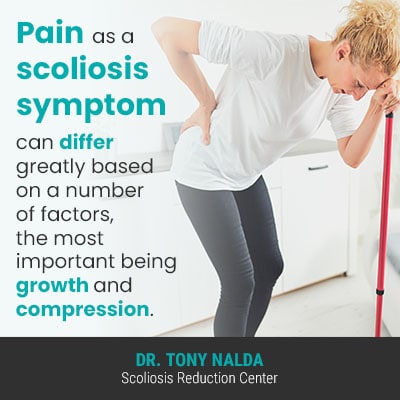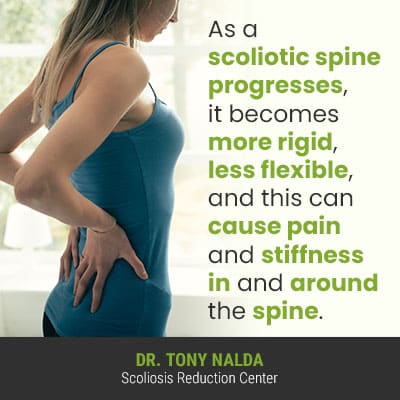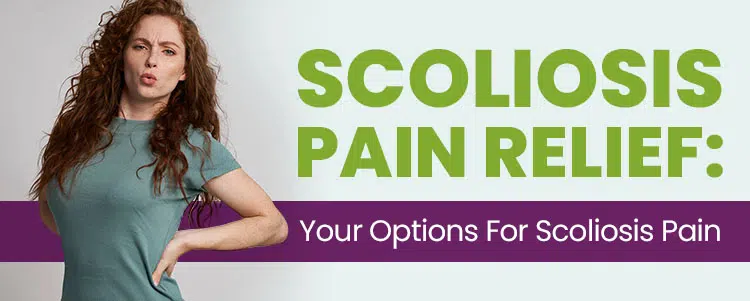While every case is different, pain related to scoliosis can include back and/or muscle pain, radicular pain felt throughout the body, and headaches that can reach migraine status. Scoliosis pain relief is best delivered through proactive treatment that, first and foremost, impacts the condition on a structural level.
Scoliosis is a highly variable condition that can range from mild to moderate and severe to very severe. When it comes to scoliosis pain relief, a proactive treatment that addresses its underlying cause is key. Also, adolescents and adults experience pain very differently due to growth and compression.
Before exploring the different types of pain scoliosis can cause, let’s first address what’s happening inside the body of someone recently diagnosed with a progressive spinal condition.
What it Means to be Diagnosed with Scoliosis
If someone is diagnosed with scoliosis, this means their spine has developed an unnatural sideways curvature, and in addition to bending to the side, scoliosis also includes rotation, meaning the spine twists from front to back, back to front.
As a progressive condition, scoliosis has it in its very nature to worsen over time, especially if not treated proactively.
This also means that where a condition is at the time of diagnosis is not indicative of where it will stay, and as a condition progresses from mild to moderate, severe to very severe, this means the scoliotic curve increases in size, and symptoms tend to increase alongside severity, including pain.
There are also different types of scoliosis that can develop, including idiopathic, neuromuscular, congenital, degenerative (de novo), and traumatic.
While scoliosis is most commonly diagnosed in children and adolescents, it also affects adults, but when it comes to pain, adolescents and adults tend to have very different experiences of life with the condition.
Pain as a Scoliosis Symptom

Pain as a scoliosis symptom can differ greatly based on a number of factors, the most important being growth and compression.
In the condition’s most prevalent form, adolescent idiopathic scoliosis (AIS), diagnosed between the ages of 10 and 18, early detection can be challenging, and this is due to the condition not commonly causing noticeable pain.
While pain isn’t something anyone wants to experience when it comes to reaching a diagnosis, it’s an important indicator that something is wrong inside the body. When a condition isn’t overly painful, early detection isn’t always easy.
While we know that growth and development are the condition’s number-one trigger for progression, we also know that in children and adolescents, growth keeps the condition from being overly painful due to compression.
It’s compression of the spine and its surrounding muscles and nerves that is known as the main source of condition-related pain, and the lengthening motion of a growing spine counteracts the compressive force of the unnatural spinal curve, but in adults, as skeletal maturity has been reached, the spine has settled due to gravity and maturity, so the condition becomes compressive and painful.
In fact, it’s pain that brings most adults in to see me for a diagnosis and treatment; in adolescents, it’s most often postural changes that are the earliest noticeable indicators of the condition.
So now that we understand why pain as a scoliosis symptom differs in adolescents versus adults, let’s talk about the different types of pain scoliosis can cause.
Back and Radicular Pain
As a structural condition, scoliosis involves a structural abnormality within the spine itself, which is why proactive treatment has to, first and foremost, impact the condition on a structural level.

As a scoliotic spine progresses, it becomes more rigid, less flexible, and this can cause pain and stiffness in and around the spine.
As compression also affects the spinal nerves, this is how radicular pain can become an issue and is commonly felt in the legs and feet; remember, nerves are like limbs of a tree, branching off in multiple directions, so nerve pain can be felt far from the original compression site.
While nerve-related back pain can range from mild and intermittent to chronic and debilitating, it’s commonly known as the worst form of back pain.
Sciatica can also be an issue for adults living with scoliosis as the sciatic nerve is the largest nerve in the body consisting of 5 nerve roots that originate in the lower back and extend down the buttocks, legs, and into the feet.
For those experiencing condition-related back pain, it’s often described as feeling uneven, pulled to one side, and/or being weighed down. Often, back pain gets worse during long periods of standing or sitting, and a stiff spine with less flexibility will likely cause activity restrictions.
Muscle Pain
In addition to back and radicular pain, scoliosis can also cause muscle pain, and this is because compression also affects the muscles surrounding the spine.
The spine’s natural and healthy curves make it stronger, more flexible, and better able to absorb/distribute mechanical stress, but it’s not just the spine that’s charged with maintaining its natural curves; that task is shared by the core/spinal muscles.
As a spine bends and twists unnaturally, the muscles that run alongside the spine are also exposed to those uneven forces, causing excess wear and tear as they struggle to support and stabilize a scoliotic spine’s unnatural position and progression.
Muscles that are strained can become sore, stiff, and painful, and approximately 20 percent of adolescents also report muscle pain as part of their experience of life with the condition.
So before heading into the topic of how proactive treatment can provide scoliosis pain relief, let’s first address another type of condition-related pain: headaches.
Headaches and Migraines
While many assume that a spinal condition like scoliosis would mainly affect the back, its symptoms can be felt in other areas of the body, like the head.
Scoliosis is associated with headaches that can reach migraine status due to disruptions in the flow/level of cerebrospinal fluid (CSF) that helps protect the spine and brain.
If the spine is unnaturally curved, the flow of CSF within can be disrupted and cause lower levels in and around the brain, and this can cause headaches of varying severity, with the potential to reach migraine status.
As scoliosis can affect the body in multiple ways and cause various types of back, radicular, and muscle pain, as well as headaches, what can be done about it?
Scoliosis Pain Relief and Proactive Treatment
When it comes to scoliosis pain relief, the single best remedy is a proactive treatment that addresses the condition’s underlying cause, and this will be driven by condition type: idiopathic, neuromuscular, congenital, degenerative, and traumatic.
Different types of scoliosis have different treatment needs, and as idiopathic scoliosis is the most common type to affect both adolescents and adults, we’ll focus on treatment for this form currently.
While many consider pain medication as a form of treatment, pain is merely a symptom of scoliosis, but not the underlying condition or cause, and there is a big difference between addressing symptoms of a condition and treating the actual condition itself: the underlying cause of pain.
Here at the Scoliosis Reduction Center®, my first step toward treatment is assessing the condition, determining its underlying cause (if known), and crafting a customized and effective treatment plan around it.
While we don’t know what causes the development of idiopathic scoliosis, we know that its growth and development which triggers its progression, so proactive treatment that manages progression and prevents increasing condition severity is key.
I offer patients a conservative chiropractic-centered treatment approach that integrates multiple treatment disciplines for the most specialized and positive results.
Through a combination of condition-specific chiropractic care, in-office therapy, custom-prescribed home exercises, and corrective bracing, I can help patients work towards a curvature reduction and increasing core strength, so the spine is optimally supported by its surrounding muscles.
Through a variety of chiropractic techniques, I can work towards adjusting the most-tilted vertebrae of the curve back into alignment with the rest of the spine; by impacting the condition on a structural level, this reduces a lot of the uneven forces the condition introduces to the body and eases symptoms such as postural deviation and pain.
Through physical therapy and a variety of scoliosis-specific exercises (SSEs) and stretches, I can help patients increase their core strength, spinal strength, and the flexibility of the spine and core muscles: keeping the spine and surrounding muscles as loose and flexible as possible means muscles are less strained and painful.
In addition, when SSEs are integrated into a proactive treatment plan and performed as prescribed, they can help activate certain areas of the brain to improve brain-body communication and body positioning.
Through the use of corrective bracing, like the ScoliBrace, I can help patients augment structural treatment results by pushing the spine into a corrective positive while addressing its 3-dimensional nature.
Bracing can also be an effective pain management tool in adult scoliosis by helping to stabilize the spine and, is often prescribed for part-time wearing and short-term pain relief.
While there are no treatment guarantees, for those wanting a sustainable and effective way to manage condition-related pain, impacting the condition on multiple levels by combining different forms of treatment and apportioning them according to how the spine responds to treatment is optimal for scoliosis pain relief in the long term.
Conclusion
When it comes to your options for scoliosis pain relief, it’s important to keep in mind that there is a big difference between short-term pain relief and long-term condition/pain management.
Although scoliosis is a spinal condition, it can cause pain felt in other areas of the body, and not just the back: radicular pain, muscle pain, and headaches/migraines.
While there are always medications that work in masking pain for the short term, there is also a cost to that as pain can reveal the condition’s need for treatment and continued progression, so for those not undergoing proactive treatment while taking pain medication, this can be quite harmful as medications can disguise the need for treatment as conditions worsen.
Here at the Scoliosis Reduction Center®, for those experiencing condition-related pain, mainly my adult patients, I encourage proactive treatment that addresses the underlying cause of the pain: the condition itself.
While there are no treatment guarantees, impacting the condition, first and foremost, on a structural level addresses the underlying structural nature of the condition, and this reduces the uneven forces being introduced to the body: the source of compression and related radicular, back, and muscle pain.





